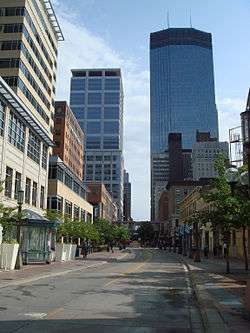Nicollet Avenue

Nicollet Avenue is a major street in Minneapolis, Minnesota and three of its suburbs. It passes through a number of locally well-known neighborhoods and districts, notably Eat Street in south Minneapolis and the traffic-restricted Nicollet Mall in the city's downtown.
It began as a military road between St. Anthony Falls and Fort Snelling. Nicollet Avenue was named for early 19th-century French explorer and cartographer Joseph Nicollet, who led three expeditions in what is now Minnesota. Nicollet Mall occupies the oldest section of the avenue. Before the mall was constructed in 1968, Nicollet Avenue stretched from the Mississippi River to the Minnesota River.
Technically, the avenue begins at Grant Street in Loring Park and continues south to West 29th Street/Cecil B. Newman Lane, where it is interrupted by a K-Mart store, and begins again at Lake Street, continuing through Richfield and Bloomington to 107th Street just north of the Minnesota River. Across the river in Burnsville, Nicollet begins again at Cliff Road West and ends at County Road 42. Nicollet is a city street in Minneapolis and Burnsville, while it is designated as Hennepin County Road 52 between 98th Street in Bloomington and Crosstown Highway 62 in Richfield. This designation resumes on Hennepin Avenue in downtown Minneapolis, though the county highway is not contiguous.
One block of the street between 29th Street and Lake Street was removed in the 1970s to build a K-Mart store which covers two city blocks, detouring southbound traffic to Blaisdell Avenue and northbound traffic to First Avenue South. The city of Minneapolis has plans to restore Nicollet Avenue by reconstructing the K-Mart site into a new configuration that would include both commercial and residential development.[1]
The Metro Transit route 18 bus travels most of Nicollet Avenue. Historically, Nicollet had rail transportation, starting with the Minneapolis, Lyndale & Minnetonka Railway Co., also known as the "Motor Line". The Motor Line ran along Marquette Avenue in downtown Minneapolis, then turned west for one block at 13th Street South to reach Nicollet. The line was constructed south to 31st Street in 1879, to 37th Street in 1884, and was extended further south to 50th Street in 1887. It was converted to streetcar operation in 1890, and the Twin City Rapid Transit Company (TCRT) extended the route to Diamond Lake Road in 1911, 58th Street in 1928, and 62nd Street (now Minnesota State Highway 62) in 1947. Streetcars on the road had a service frequency of one every 5 minutes off-peak, and ran about twice as often during the morning and afternoon peak periods.[2]
The Dan Patch Line, a separate railroad serving communities as far south as Northfield, Minnesota, ran parallel to the streetcar line between 60th Street and Diamond Lake Road. Nicollet Station, a carhouse originally built for the Motor Line, was kept and expanded by TCRT, but was torn down as the system was dismantled in 1953–1954. The station was located at Nicollet and 31st Street, just south of the Minneapolis Millers' Nicollet Park baseball field, which itself closed in 1955.[2]
In popular culture
The avenue was used as a backdrop for the end of the famous opening sequence of The Mary Tyler Moore Show, in which a jubilant Moore tosses her hat into the air while watched by a curious group of passersby who were, in fact, real people and not extras.
References
- ↑ "Nicollet Avenue Bridge Reopening". City of Minneapolis. Retrieved September 16, 2010.
- 1 2 John W. Diers and Aaron Isaacs (2007). Twin Cities by Trolley: The Streetcar Era in Minneapolis and St. Paul. Minneapolis and London: University of Minnesota Press. ISBN 978-0-8166-4358-5.
| Wikimedia Commons has media related to Nicollet Avenue. |
Coordinates: 44°58′35″N 93°16′22″W / 44.9763329°N 93.2726852°W